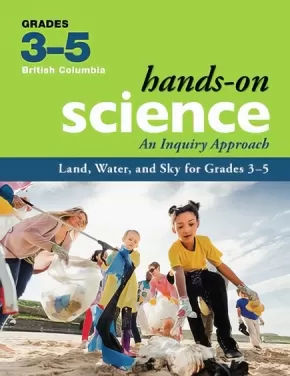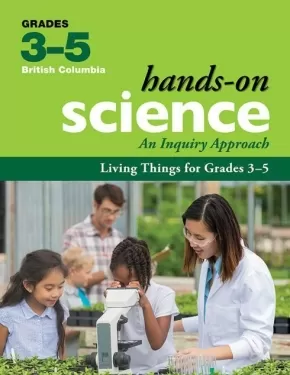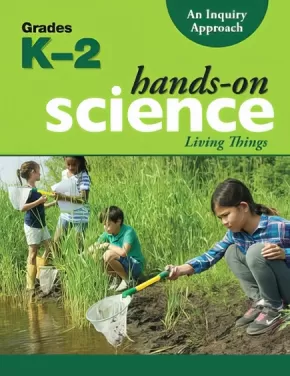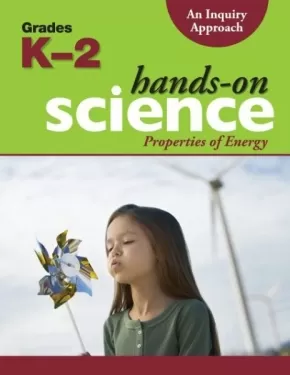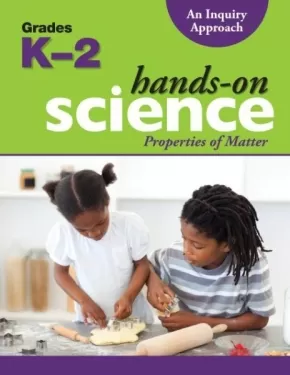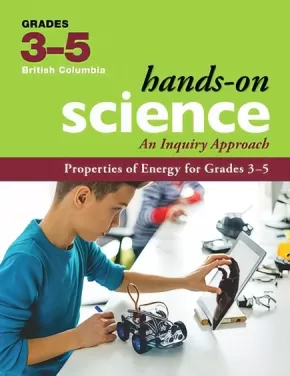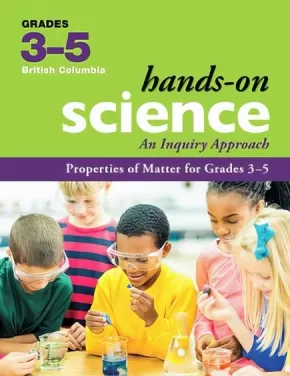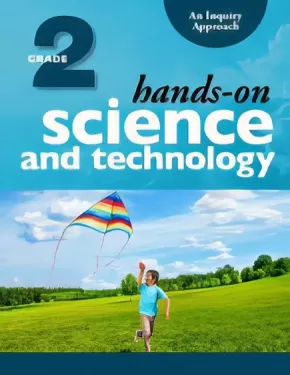Jennifer Lawson
Jennifer Lawson, PhD, is the originator and senior author of the Hands-On series in all subject areas. Jennifer is a former classroom teacher, resource/special education teacher, consultant, and principal. She continues to develop new Hands-On projects, and also serves as a School Trustee for the St. James-Assiniboia School Division in Winnipeg, Manitoba.
Books (9)
Synopsis:
Land, Water, and Sky from Hands-On Science: An Inquiry Approach completely aligns with BC’s New Curriculum for science. Grounded in the Know-Do-Understand model, First Peoples knowledge and perspectives, and student-driven scientific inquiry, this custom-written resource:
- emphasizes Core Competencies, so students engage in deeper and lifelong learning
- develops Curricular Competencies as students explore science through hands-on activities
- fosters a deep understanding of the Big Ideas in science
Using proven Hands-On features, Land, Water, and Sky contains information and materials for both teachers and students including: Curricular Competencies correlation charts; background information on the science topics; complete, easy-to-follow lesson plans; reproducible student materials; and materials lists.
Innovative new elements have been developed specifically for the new curriculum:
- a multi-age approach
- a five-part instructional process—Engage, Explore, Expand, Embed, Enhance
- an emphasis on technology, sustainability, and personalized learning
- a fully developed assessment plan for summative, formative, and student self-assessment
- a focus on real-life Applied Design, Skills, and Technologies
- learning centres that focus on multiple intelligences and universal design for learning (UDL)
- place-based learning activities, Makerspace centres, and Loose Parts
In Land, Water, and Sky students investigate characteristics of the land, water, and sky. Core Competencies and Curricular Competencies will be addressed while students explore the following Big Ideas:
- Daily and seasonal changes affect all living things.
- Observable patterns and cycles occur in the local sky and landscape.
- Water is essential to all living things, and it cycles through the environment.
Educator Information
This book is from the Hands-On Science: An Inquiry Approach (for BC) series. The new Hands-On Science comprehensive resources completely align with the redesigned Science Curriculum for British Columbia.
Recommended for grades 3 to 5.
Indigenous Consultant: Desiree Marshall-Peer, Cree-Ojibway
Indigenous Contributor: Melanie Nelson, Stó:lo¯ and In-SHUCK-ch
Table of Contents
Introduction to Hands-On Science
About Hands-On Science
Format of Hands-On Science
The Multi-Age Approach
Inquiry and Science
The Goals of Science Education in British Columbia
Hands-On Science Principles
Cultural Connections
Indigenous Perspectives and Knowledge
References
How to Use Hands-On Science in Your Classroom
Multi-Age Teaching and Learning
Module Overview
Talking Circles
Multiple Intelligences Learning Centres
Icons
Makerspaces
References
Curricular Competencies: How to Infuse Scientific Inquiry Skills and Processes Into Lessons
Observing
Questioning
Exploring
Classifying
Measuring
Communicating, Analyzing, and Interpreting
Predicting
Inferring
Inquiry Through Investigation and Experimentation
Inquiry Through Research
Addressing Students’ Literacy Needs
Online Considerations
References
The Hands-On Science Assessment Plan
Student Self-Assessment
Formative Assessment
Summative Assessment
Indigenous Perspectives on Assessment
Connecting Assessment to Curricular Competencies
Module Assessment Summary
Important Note to Teachers
References
Assessment Reproducibles
What Are the Features of the Land, Water, and Sky?
About This Module
Curriculum Learning Framework: What We Know and Understand
Curricular Competencies Correlation Chart: What We Do
Resources for Students
Initiating Event: What Do We Observe, Think, and Wonder About the Earth?
What Can We Learn About the Earth Through Stories?
What Do We Know About the Earth?
What Is the Land Like in British Columbia?
How Does Water Affect the Land?
What Are the Effects of Wind and Ice on the Landscape?
Why Do We Have a Day/Night Cycle?
Why Do We Have a Year Cycle?
What Are the Phases of the Moon?
What Is an Eclipse?
What Do We Know About Rocks and Minerals?
How Can We Compare and Classify Rocks and Minerals?
How Are Different Types of Rock Formed?
What Are Some Uses for Rocks and Minerals?
Inquiry Project: How Can We Care for the Earth’s Resources?
Appendix: Image Banks
About the Contributors
Additional Information
200 pages | 8.50" x 11.00" | Spiral Bound
Synopsis:
Land, Water, and Sky from Hands-On Science: An Inquiry Approach completely aligns with the redesigned Science Curriculum for British Columbia. Grounded in the Know-Do-Understand model, First Peoples’ knowledge and perspectives, and student-driven scientific inquiry, this custom-written resource:
- emphasizes Core Competencies, so students engage in deeper and lifelong learning
- develops Curricular Competencies as students explore science through hands-on activities
- fosters a deep understanding of the Big Ideas in science
Using proven Hands-On features, Land, Water, and Sky contains information and materials for both teachers and students including: Curricular Competencies correlation charts; background information on the science topics; complete, easy-to-follow lesson plans; reproducible student materials; and materials lists.
Innovative new elements have been developed specifically for the new curriculum:
- a multi-age approach
- a five-part instructional process—Engage, Explore, Expand, Embed, Enhance
- an emphasis on technology, sustainability, and personalized learning
- a fully developed assessment plan for summative, formative, and student self-assessment
- a focus on real-life Applied Design, Skills, and Technologies
- learning centres that focus on multiple intelligences and universal design for learning (UDL)
- place-based learning activities, Makerspace centres, and Loose Parts
In Land, Water, and Sky students investigate characteristics of the land, water, and sky. Core Competencies and Curricular Competencies will be addressed while students explore the following Big Ideas:
- Daily and seasonal changes affect all living things.
- Observable patterns and cycles occur in the local sky and landscape.
- Water is essential to all living things, and it cycles through the environment.
Educator Information
This book is from the Hands-On Science: An Inquiry Approach (for BC) series. The new Hands-On Science comprehensive resources completely align with the redesigned Science Curriculum for British Columbia.
Recommended for use with children ages 4-8.
Additional Information
150 pages | 8.5 " x 11"
Synopsis:
Living Things from Hands-On Science for British Columbia completely aligns with BC’s New Curriculum for Science. Grounded in the Know-Do-Understand model, First Peoples knowledge and perspectives, and student-driven scientific inquiry, this custom-written resource:
- emphasizes Core Competencies, so students engage in deeper and lifelong learning
- develops Curricular Competencies through hands-on activities
- fosters a deep understanding of the Big Ideas in science
Using proven Hands-On features, Living Things contains information and materials for both teachers and students including: Curricular Competencies correlation charts; background information on the science topics; complete, easy-to-follow lesson plans; reproducible student materials; and materials lists.
Innovative new elements have been developed specifically for the new curriculum:
- a multi-age approach
- an emphasis on technology, sustainability, and personalized learning
- a fully developed assessment plan for summative, formative, and student self-assessment
- a focus on real-life Applied Design, Skills, and Technologies
- learning centres that focus on multiple intelligences and universal design for learning (UDL)
- place-based learning activities and Makerspaces
Living Things for Grades 3-5 addresses Core Competencies and Learning Standards while students
explore the following Big Ideas:
- Living things are diverse, can be grouped, and interact in their ecosystems.
- All living things sense and respond to their environment.
- Multicellular organisms have organ systems that enable them to survive and interact within their environment.
Educator Information
This book is from the Hands-On Science: An Inquiry Approach (for BC) series. The new Hands-On Science comprehensive resources completely align with the redesigned Science Curriculum for British Columbia.
Recommended for use with students in grades 3 to 5.
Additional Information
150 pages | 8.50" x 11.00"
Synopsis:
Living Things from Hands-On Science: An Inquiry Approach completely aligns with the redesigned Science Curriculum for British Columbia. Grounded in the Know-Do-Understand model, First Peoples’ knowledge and perspectives, and student-driven scientific inquiry, this custom-written resource:
- emphasizes Core Competencies, so students engage in deeper and lifelong learning
- develops Curricular Competencies as students explore science through hands-on activities
- fosters a deep understanding of the Big Ideas in science
Using proven Hands-On features, Living Things contains information and materials for both teachers and students including: Curricular Competencies correlation charts; background information on the science topics; complete, easy-to-follow lesson plans; reproducible student materials; and materials lists.
Innovative new elements have been developed specifically for the new curriculum:
- a multi-age approach
- a five-part instructional process—Engage, Explore, Expand, Embed, Enhance
- an emphasis on technology, sustainability, and personalized learning
- a fully developed assessment plan for summative, formative, and student self-assessment
- a focus on real-life Applied Design, Skills, and Technologies
- learning centres that focus on multiple intelligences and universal design for learning (UDL)
- place-based learning activities, Makerspace centres, and Loose Parts
In Living Things students investigate plants and animals. Core Competencies and Curricular Competencies will be addressed while students explore the following Big Ideas:
- Plants and animals have observable features.
- Living things have features and behaviours that help them survive in their environment.
- Living things have life cycles adapted to their environment.
Educator Information
This book is from the Hands-On Science: An Inquiry Approach (for BC) series. The new Hands-On Science comprehensive resources completely align with the redesigned Science Curriculum for British Columbia.
Recommended for use with children ages 4-8.
Additional Information
150 pages | 8.5 " x 11"
Synopsis:
Properties of Energy from Hands-On Science: An Inquiry Approach completely aligns with the redesigned Science Curriculum for British Columbia. Grounded in the Know-Do-Understand model, First Peoples’ knowledge and perspectives, and student-driven scientific inquiry, this custom-written resource:
- emphasizes Core Competencies, so students engage in deeper and lifelong learning
- develops Curricular Competencies as students explore science through hands-on activities
- fosters a deep understanding of the Big Ideas in science
Using proven Hands-On features, Properties of Energy contains information and materials for both teachers and students including: Curricular Competencies correlation charts; background information on the science topics; complete, easy-to-follow lesson plans; reproducible student materials; and materials lists.
Innovative new elements have been developed specifically for the new curriculum:
- a multi-age approach
- a five-part instructional process—Engage, Explore, Expand, Embed, Enhance
- an emphasis on technology, sustainability, and personalized learning
- a fully developed assessment plan for summative, formative, and student self-assessment
- a focus on real-life Applied Design, Skills, and Technologies
- learning centres that focus on multiple intelligences and universal design for learning (UDL)
- place-based learning activities, Makerspace centres, and Loose Parts
In Properties of Energy students investigate properties of energy. Core Competencies and Curricular Competencies will be addressed while students explore the following Big Ideas:
- The motion of objects depends on their properties.
- Light and sound can be produced and their properties can be changed.
- Forces influence the motion of an object.
Educator Information
This book is from the Hands-On Science: An Inquiry Approach (for BC) series. The new Hands-On Science comprehensive resources completely align with the redesigned Science Curriculum for British Columbia.
Recommended for use with children ages 4-8.
Additional Information
181 pages | 8.5 " x 11"
Synopsis:
Properties of Matter from Hands-On Science: An Inquiry Approach completely aligns with the redesigned Science Curriculum for British Columbia. Grounded in the Know-Do-Understand model, First Peoples’ knowledge and perspectives, and student-driven scientific inquiry, this custom-written resource:
- emphasizes Core Competencies, so students engage in deeper and lifelong learning
- develops Curricular Competencies as students explore science through hands-on activities
- fosters a deep understanding of the Big Ideas in science
Using proven Hands-On features, Properties of Matter contains information and materials for both teachers and students including: Curricular Competencies correlation charts; background information on the science topics; complete, easy-to-follow lesson plans; reproducible student materials; and materials lists.
Innovative new elements have been developed specifically for the new curriculum:
- a multi-age approach
- a five-part instructional process—Engage, Explore, Expand, Embed, Enhance
- an emphasis on technology, sustainability, and personalized learning
- a fully developed assessment plan for summative, formative, and student self-assessment
- a focus on real-life Applied Design, Skills, and Technologies
- learning centres that focus on multiple intelligences and universal design for learning (UDL)
- place-based learning activities, Makerspace centres, and Loose Parts
In Properties of Matter students investigate matter. Core Competencies and Curricular Competencies will be addressed while students explore the following Big Ideas:
- Humans interact with matter every day through familiar materials.
- Materials can be changed through physical and chemical processes.
- Matter is useful because of its properties.
Educator Information
This book is from the Hands-On Science: An Inquiry Approach (for BC) series. The new Hands-On Science comprehensive resources completely align with the redesigned Science Curriculum for British Columbia.
Recommended for use with children ages 4-8.
Additional Information
150 pages | 8.5" x 11"
Synopsis:
Properties of Energy from Hands-On Science: An Inquiry Approach completely aligns with BC’s New Curriculum for science. Grounded in the Know-Do-Understand model, First Peoples knowledge and perspectives, and student-driven scientific inquiry, this custom-written resource:
- emphasizes Core Competencies, so students engage in deeper and lifelong learning
- develops Curricular Competencies as students explore science through hands-on activities
- fosters a deep understanding of the Big Ideas in science
Using proven Hands-On features, Properties of Energy contains information and materials for both teachers and students including: Curricular Competencies correlation charts; background information on the science topics; complete, easy-to-follow lesson plans; reproducible student materials; and materials lists.
Innovative new elements have been developed specifically for the new curriculum:
- a multi-age approach
- a five-part instructional process—Engage, Explore, Expand, Embed, Enhance
- an emphasis on technology, sustainability, and personalized learning
- a fully developed assessment plan for summative, formative, and student self-assessment
- a focus on real-life Applied Design, Skills, and Technologies
- learning centres that focus on multiple intelligences and universal design for learning (UDL)
- place-based learning activities, Makerspaces, and Loose Parts
In Properties of Energy, students investigate properties of energy. Core Competencies and Curricular Competencies will be addressed while students explore the following Big Ideas:
- The motion of objects depends on their properties.
- Light and sound can be produced and their properties can be changed.
- Forces influence the motion of an object.
Educator & Series Information
This book is from the Hands-On Science: An Inquiry Approach (for BC) series. The new Hands-On Science comprehensive resources completely align with the redesigned Science Curriculum for British Columbia.
Recommended for use with students in grades 3 to 5.
Additional Information
200 pages | 8.50" x 11.00"
Synopsis:
Properties of Matter from Hands-On Science for British Columbia completely aligns with BC’s New Curriculum for Science. Grounded in the Know-Do-Understand model, First Peoples knowledge and perspectives, and student-driven scientific inquiry, this custom-written resource:
- emphasizes Core Competencies, so students engage in deeper and lifelong learning
- develops Curricular Competencies through hands-on activities
- fosters a deep understanding of the Big Ideas in science
Using proven Hands-On features, Properties of Matter contains information and materials for both teachers and students including: Curricular Competencies correlation charts; background information on the science topics; complete, easy-to-follow lesson plans; reproducible student materials; and materials lists.
Innovative new elements have been developed specifically for the new curriculum:
- a multi-age approach
- an emphasis on technology, sustainability, and personalized learning
- a fully developed assessment plan for summative, formative, and student self-assessment
- a focus on real-life Applied Design, Skills, and Technologies
- learning centres that focus on multiple intelligences and universal design for learning (UDL)
- place-based learning activities and Makerspaces
Properties of Matter for Grades 3-5 addresses Core Competencies and Learning Standards while students
explore the following Big Ideas:
- All matter is made of particles.
- Matter has mass, takes up space, and can change phase.
- Solutions are homogeneous.
Educator Information
This book is from the Hands-On Science: An Inquiry Approach (for BC) series. The new Hands-On Science comprehensive resources completely align with the redesigned Science Curriculum for British Columbia.
Recommended for use with students in grades 3 to 5.
Additional Information
200 pages | 8.50" x 11.00"
Synopsis:
Hands-On Science and Technology: An Inquiry Approach is filled with a year’s worth of classroom-tested activity-based lesson plans. The grade 2 book is divided into four units based on the current Ontario curriculum for science and technology:
- Growth and Changes in Animals
- Movement
- Properties of Liquids and Solids
- Air and Water in the Environment
This new edition includes many familiar great features for both teachers and students: curriculum correlation charts; background information on the science and technology topics; complete, easy-to-follow lesson plans; reproducible student materials; materials lists; and hands-on, student-centred activities.
Useful new features include:
- the components of an inquiry-based scientific and technological approach
- Indigenous knowledge and perspective embedded in lesson plans
- a four-part instructional process—activate, action, consolidate and debrief, and enhance
- an emphasis on technology, sustainability, and differentiated instruction
- a fully developed assessment plan that includes opportunities for assessment for, as, and of learning
- a focus on real-life technological problem solving
- learning centres that focus on multiple intelligences and universal design for learning (UDL)
- land-based learning activities
- a bank of science-related images
Educator& Series Information
This book is from the Hands-On Science: An Inquiry Approach (for Ontario) series.
Recommended for grade 2.
Includes some Indigenous content/perspectives from Indigenous Consultant Kevin Reed.
Additional Information
|

